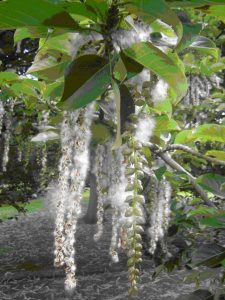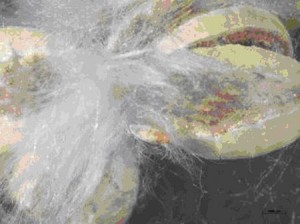Packaging; one of the 21st century’s environmental issues. The Poplar has a similar issue. How do you protect the gene pool of the next generation? Take a walk to the Birch lawn and be met by a cloud of soft silky strands floating in the breeze. These silk like hairs protect the seed of Populus maximowiczii, a native of eastern and northern Asia where it is a forest tree. Here in the garden it leafs very early in the spring, often showing damage on the young leaves after an overnight frost.
The seed pods are arranged down the catkin which can reach 300mm in length. Well spaced to allow the capsule to split reflexing into (generally) four segments releasing the compressed cotton and seed to the wind. On a calm day the ground beneath is covered in a carpet of white hairs.
Forget ideas of the Dandelion clock. The Dandelion seed head is composed of a multitude of seeds directly attached to the pappus or parachute whose aim is to lift the seed from the parent plant and take it away in the wind for dispersal. In the Poplar seed pod there are several light brown seeds held independent of a parachute mechanism.
These microscope images taken by Frieda Christie show the seed cocooned within a mass of compressed hairs. As the seed capsule ripens the four way split across the seed pod allows the dense mass of silky hairs to expand out and separate. Buried in this protective cocoon are seeds, less than and up to 2mm in length. They use these light strands of hair to piggyback a ride on, floating off in the summer air currents.


